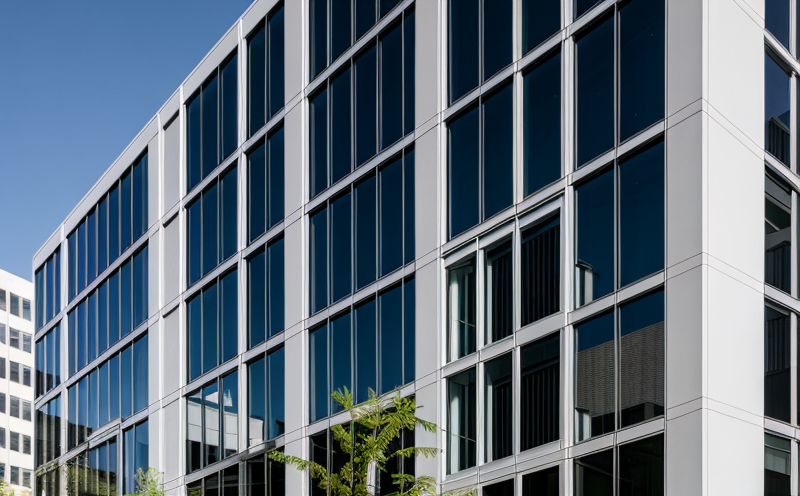ISO 9050 Light Transmittance and Solar Factor Measurement
The ISO 9050 standard provides a comprehensive framework for measuring light transmittance (LT) and solar factor (SF) of building materials, including glass and ceramics used in façades. This service ensures that the optical properties of these materials comply with international standards, thereby enhancing the energy efficiency, comfort, and aesthetics of buildings.
Light transmittance refers to the amount of light transmitted through a material relative to incident light, while solar factor measures how much heat is allowed into a building via radiation from sunlight. Accurate measurement of these parameters is crucial for optimizing thermal performance and reducing cooling costs in modern architectural designs.
To perform an ISO 9050 test, the specimen must be prepared according to specific guidelines outlined in the standard. This typically involves cutting samples with precise dimensions that ensure accurate representation of the material's optical properties under real-world conditions. The testing process itself requires specialized equipment such as integrating spheres and spectrophotometers calibrated per manufacturer specifications.
The accuracy of LT/SF measurements directly impacts decisions made during architectural design phases regarding glazing selection, insulation strategies, and overall building envelope performance. By adhering strictly to ISO 9050 procedures, laboratories can provide reliable data that informs sustainable construction practices and contributes significantly towards achieving LEED certification goals.
Our team of experts uses state-of-the-art facilities equipped with high-precision instruments calibrated regularly against international standards. Our methodological approach ensures consistent results across multiple projects, giving clients peace of mind knowing they receive unbiased performance metrics for their materials.
In summary, ISO 9050 compliance is essential for any organization involved in the design or manufacturing of glass and ceramic products intended for use within building envelopes. The service offered here guarantees precise measurement of light transmittance and solar factor, contributing to more efficient energy usage and sustainable development efforts.
Applied Standards
The ISO 9050 standard is widely recognized in the construction industry for its rigorous methodology in determining light transmittance (LT) and solar factor (SF). This international consensus document serves as a benchmark against which laboratories measure their capabilities to deliver accurate results. It specifies detailed procedures from sample preparation through final reporting, ensuring that all participants adhere uniformly to best practices.
By adopting ISO 9050, organizations demonstrate commitment to quality assurance and continuous improvement processes. The standard emphasizes the importance of traceability throughout every stage of testing—from initial contact with customers until delivery of reports—ensuring transparency about methodologies employed and conclusions drawn based on empirical evidence.
Beyond compliance with ISO 9050 itself, many jurisdictions require certification from accredited bodies like ANSI or UKAS before undertaking certain types of assessments. Our facility holds multiple accreditations necessary for conducting these specialized tests accurately and reliably.
Customer Impact and Satisfaction
The implementation of ISO 9050 light transmittance and solar factor measurement services has profound implications for both clients and broader society. For businesses operating within the building sector, this service translates into tangible benefits such as enhanced product performance, reduced operational costs, improved brand reputation, and increased market competitiveness.
From an environmental perspective, accurate LT/SF measurements contribute positively toward achieving green building certifications like LEED or BREEAM. These credentials are increasingly sought after by environmentally conscious clients who demand sustainable solutions from their suppliers. By meeting these criteria through rigorous testing protocols aligned with ISO 9050, companies can expand their customer base while simultaneously promoting responsible resource stewardship.
Moreover, satisfied customers often translate into repeat business opportunities and positive word-of-mouth referrals. This is particularly true in competitive markets where reputation plays a crucial role in securing long-term relationships. Our dedication to delivering precise results fosters trust between us and our clients, ensuring lasting partnerships built on mutual respect and shared goals.
Use Cases and Application Examples
The application of ISO 9050 light transmittance and solar factor measurement is extensive across various sectors within the building industry. Architects, engineers, contractors, and manufacturers all rely on these measurements to make informed decisions about material selection, design optimizations, and compliance verification.
Architects often use LT/SF data during early stages of project planning to select appropriate glazing types that balance aesthetic appeal with functional requirements such as natural lighting levels and heat retention capabilities. Engineers apply this information when designing energy-efficient facades capable of minimizing heating loads during winter months while controlling unwanted heat gain in summer.
Contractors benefit from accurate LT/SF measurements by ensuring proper installation techniques that maximize performance potential without compromising safety or durability standards. Manufacturers leverage these tests to validate new product offerings, compare existing products against competitors' offerings, and continuously refine manufacturing processes based on feedback received from independent laboratories.
A specific example involves a client who sought to verify whether their newly developed double-glazed window unit met specified LT/SF targets set forth by local regulations. Our laboratory conducted ISO 9050-compliant tests on several units under controlled conditions, providing detailed reports highlighting areas where improvements could be made before mass production began.
Another instance involved a large-scale renovation project involving hundreds of existing windows requiring re-certification to meet updated energy efficiency standards. By using our ISO 9050 services, the client was able to expedite compliance verification without disrupting ongoing operations or incurring unnecessary delays.





